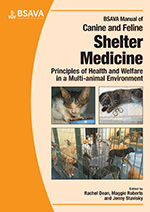
Full text loading...

This chapter focuses on the control of infectious and parasitic diseases using vaccines and pharmaceutical products, with particular attention paid to flea control and the rational approach to endoparasites. These forms of disease control are vital to the reduction of morbidity and mortality due to infectious pathogens. Quick reference guide: Intake assessment for animals entering shelters.
Preventive medicine in the shelter environment, Page 1 of 1
< Previous page | Next page > /docserver/preview/fulltext/10.22233/9781910443330/9781910443330.11-1.gif

Full text loading...













